Table of Contents
Dynamo hubs are becoming more and more common on bikes used for bicycle touring and bikepacking. This can be attributed to recent improvements in dynamo hub power outputs and efficiency, LED light advancements and ever-upgrading charging technology.
There are only a handful of dynamo hubs on the market, but there are some significant differences between them. This article will delve into everything you should know about dynamo hubs.
Dynamo Hub Types
Axle Sizes
The most common size for a touring bike is still 9mm quick release, but with axle standards changing both on-road and off-road, we’re now finding touring and bikepacking bikes available with six axle variants.
1. Quick Release 9mm – 100mm
2. Thru Axle Road 12mm – 100mm
3. Thru Axle MTB 15mm – 100mm
4. Thru Axle MTB Boost 15mm – 110mm
5. Fat Bike Quick Release – 135mm
6. Fat Bike Thru-Axle 15mm – 150mm
Connectors
There are two different common forms of spade connector – the Shimano design and the Schmidt SON design. Neither design can be said to be ‘better’ – they both do the same job of transmitting power up the cable. Due to the market split of connector types, dynamo lights and USB chargers tend to come without any connector attached to the cable ends.
A less common connector design is the Schmidt SL fork dropout. This is a really neat design; the connection happens between the edge of the hub and a fork dropout plate that’s soldered to the wiring. Almost every Schmidt hub is made in an SL version. Unfortunately, you’ll rarely find the Schmidt SL dropout on anything but custom-built forks.

Power Specification
There are three different power specifications for dynamo hubs: 1.5-watts, 2.4-watts or 3-watts (all at 6-volts). Given that touring and bikepacking is often conducted at speeds below 25KPH/15MPH, the most powerful option (3W) is necessary for charging USB devices, and it’s the best for low-speed lighting too. That said, 2.4W hubs offer enough power if you’re touring using smaller diameter wheels (16-20″) and 1.5W hubs are appropriate for lighting your way at higher speeds (ie. 25KPH/15MPH).
Spoke Count
Dynamo hubs come with anything from 20 spoke holes for a lightweight carbon wheel builds through to 48 holes for the strongest tandem wheel. Most touring and bikepacking bikes use between 28 and 36 spokes. While spoke count makes some difference, evenly balanced spoke tension across the wheel and a stiff touring rim tend to matter most in terms of strength.
Performance: Dynamo Hub Power Output
At different speeds, dynamo hubs offer varying amounts of power for your lights and USB chargers. The amount of power a dynamo hub delivers will depend mostly on the light or USB charger – but there are also a few tricks dynamo hub manufacturers use to boost their power outputs.
Dynamo hubs paired with powerful USB chargers will provide smartphone levels of charging from about 12KPH (look for 2.5W on the graph). That said, some hub and charger combinations will not deliver 2.5-watts until around 20KPH.
When we compare the power outputs at different speeds for the kLite USB charger (see graph above), you’ll notice the green line of the Shimano UR700 is offering the most power at all speeds, and the red line of the SP PD-8 the least. At 15KPH the UR700 is delivering three times the power output – quite significant considering the hubs both have the same 3W power specification.
That said, if you want high power outputs from your dynamo hub, you have to pay for it with additional drag.
Performance: Dynamo Hub Drag
If you’ve ever picked up a dynamo hub and tried to spin the axle, you’ll know that they feel incredibly ‘notchy’. This is the result of a series of powerful magnets passing a coil and in turn, creating an electric charge. With no light or USB charger connected, this drag only has a small effect on your speed because of the flywheel effect of a rotating wheel. According to the graph above, the drag is between 1 and 5-watts depending on the cycling speed and hub model.
When you connect a light or charger to the hub, the drag will increase. The amount of drag is mostly a function of the light or USB charger that you have connected, but there are variations between hubs too. The graph above shows how four different dynamo hubs perform with the brightest dynamo light currently available, the kLite Bikepacker Ultra. As you can see, the drag increases with the output power and speed. At maximum brightness when using the SP PD-8 hub (25KPH), the drag at the hub is around 24.5-watts, which is likely to be somewhere between 12-20% of your total pedal power. That’s a lot.
You can read the full dynamo hub testing analysis HERE.
Performance: Dynamo Hub Efficiency
A more efficient hub will turn more of your pedal power into power for your lights or charger. We can find out how efficient a dynamo hub is by comparing its power output and drag at different speeds.
The rate of efficiency is quite different for different hubs. For example, at 15KPH a Schmidt SON28 hub provides 1.9-watts to your USB device but will take 3.2-watts of your pedal power (see graph above). That means 59% of the SON28 resistance will be going towards charging your device. In comparison, the SP PD-8 will create 0.9-watts but will take 4.6-watts. In this case, only 20% of the PD-8 resistance will go to charging your device.
Charging Test Averages (Four Different Chargers):
1. SON28 Hub – 57% efficient
2. 3D32 Hub – 44% efficient
3. UR700 Hub – 39% efficient
4. PD-8 Hub – 34% efficient
Lighting Test Averages (Four Different Dynamo Lights):
SON28 Hub – 44% efficient
3D32 Hub – 37% efficient
PD-8 Hub – 31% efficient
UR700 Hub – 30% efficient
You can read the full dynamo hub efficiency results HERE.
Schmidt SON Dynamo Hubs (3W)
Schmidt is the industry standard for dynamo hubs in terms of both efficiency and reliability. These German-made hubs are also the most expensive. Despite this, they’ve been my dynamo hubs of choice since 2008. The bearings are not expected to need servicing until well after 50,000km due to a combination between robust weather sealing and the high-quality SKF sealed bearings (I’ve never actually had to replace the bearings in any of my hubs). Included with Schmidt hubs is a five-year guarantee too.
Schmidt hubs have been tested to have the lowest resistance without a device or light connected – just 1.4 to 1.9-watts of resistance (10-30KPH). And with a light or USB charger connected, they generate the lowest drag of all hubs, resulting in a charging efficiency of 57% and a lighting efficiency of 44% on average.
Quick Release
SON28 non-disc – 32, 36h
SON28 disc – 28, 32, 36h
SON28 Tandem – 40, 48h
SON28 disc 135 – 32h
SON28 disc 135 VR – 32h
Thru Axle – Disc
SON28 12mm – 28, 32, 36h
SON28 15mm – 28, 32, 36h
SON28 15mm Boost 110 – 32, 36h
SON28 15mm 150 – 32h
Shutter Precision SP Dynamo Hubs (3W)
SP dynamo hubs are the lightest dynamo hubs available and are also quite modest in price. The latest generations are known to be very reliable, but unfortunately, they’re not the best performers – they have a lower rate of efficiency and power output compared to other hubs. That said, SP makes some unique hub configurations you won’t find elsewhere, including for road bikes with a low spoke counts (20 and 24-hole). In addition, their 15mm thru-axle hubs are literally half the cost of a Schmidt. SP gives you the choice between brake rotor mounts on many hubs: 6-bolt (eg. PD-8X) or centerlock (eg. PL-8X).
Quick Release
PV-8 non-disc – 20, 24, 28, 32, 36h
PD-8 disc – 20, 24, 28, 32, 36h
Thru Axle – Disc
PD-8X-M 12mm – 32, 36h
PD-8X 15mm – 32, 36h
PD-8X-110 15mm – 32, 36h
PD-8X-150 15mm – 32, 36h
Shimano Dynamo Hubs (3W)
Shimano makes the majority of the world’s dynamo hubs, so it’s safe to say that they know a thing or two about them. Shimano hubs are very reliable, serviceable and usually the cheapest too. On top of that, they’re brilliant performers. The latest model, the UR700, is the most powerful dynamo hub available (highly recommended for off-road or hilly regions), while the rest of the hubs work out to have the second-best charging and lighting efficiency.
The Deore LX and Alfine models are essentially the same, while the Deore XT dynamo hub sheds 56 grams thanks to an aluminium axle and coil. The top-of-the-line dynamo hubs (UR700 and UR705) save a further 30-50 grams.
Quick Release
Alfine S501 disc – 32, 36h
Deore LX T670 non-disc – 32, 36h
Deore LX T675 disc – 32, 36h
Deore LX 3N72 non-disc – 32, 36h
Deore LX 3D72 disc – 32, 36h
Deore XT T8000 disc – 32, 36h
UR700 disc – 32, 36h
Thru Axle – Disc
UR705 12mm – 32, 36h
KT Dynamo Hubs (3W)
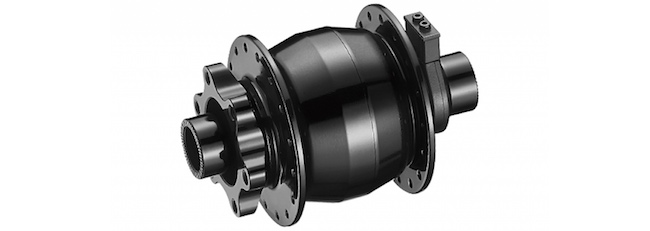
KT has recently released a dynamo hub range including a hub with a rather innovative end-cap design. By switching out the end-caps, you’ll be able to interchange your dynamo wheel between bikes that employ QR, 12mm or 15mm axles. You can get the hub in either the standard 100mm hub width or to suit 110mm Boost forks, and the disc brake hub models are available with 6-bolt (eg. KD5F) or a centerlock (eg. KC5F) brake rotor mounts. KT hubs employ the same hub shell as the SP Dynamo hubs, although internally they have their own circuitry which is yet to be tested for output power, drag, efficiency or long-term reliability.
Quick Release
KD6F disc – 32, 36h
KV6F non-disc – 32, 36h
Thru Axle – Disc
KD5F 9mm 12mm 15mm – 28, 32, 36h
KD1F 9mm 12mm 15mm Boost 110 – 28, 32, 36h
Note: the KT KD5F Dynamo is rebranded under the manufacturer “TFHPC”.
Kasai Dynamo Hubs (3W)
Kasai has released a hub called the FS Dynacoil. While most dynamo hubs are sealed at the factory and cannot be repaired yourself, this dynamo is field serviceable. Using a 36mm flat wrench, you have access to both the coil assembly and hub bearings. That means that if your hub stops providing power, you can replace the coil assembly yourself (hopefully under warranty) without having to re-lace a new wheel. In addition, when your sealed bearings inevitably wear out, you can replace them too.
Like the KT hub, we don’t yet have any idea how durable the Kasai is, along with its output power, drag or efficiency data – but Kasai is claiming 72% efficiency at 10mph (likely using a resistor). The hub weighs between 445 and 495 grams depending on the model.
Quick Release
Dynacoil FS non-disc – 32h, 36h
Dynacoil FS disc – 32h, 36h
Thru Axle – Disc
Dynacoil FS 15mm Center Lock – 32h, 36h
Dynacoil FS 15mm 6-Bolt – 32h, 36h
Other Dynamo Hubs (3W)
Biologic Joule 3 Disc – Re-branded 32h Shutter Precision PD-8 hubs in silver or black.
Exposure Disc – Another re-branded 32h SP PD-8 hub available in a package with the Exposure Revo dynamo light.
Love Mud Juice Disc – More re-branded 32h SP PD-8 hubs!
Neco Rove Disc – The claims are pretty lofty for this 933g dynamo hub with built-in USB charger – 15W of charging potential (5V@3A). Unfortunately, the testing has shown that you need to be going 50KPH to achieve that figure and that it isn’t at all competitive below 25KPH.
Sanyo H27 Non-Disc – This is one of the best value dynamo hubs going around. Unfortunately, it has a lot of drag compared to other hubs, even with lights or USB chargers switched off.
Learn About Dynamo Hub Systems HERE, About Buffer Batteries HERE, About USB Chargers HERE and Dynamo Lights HERE



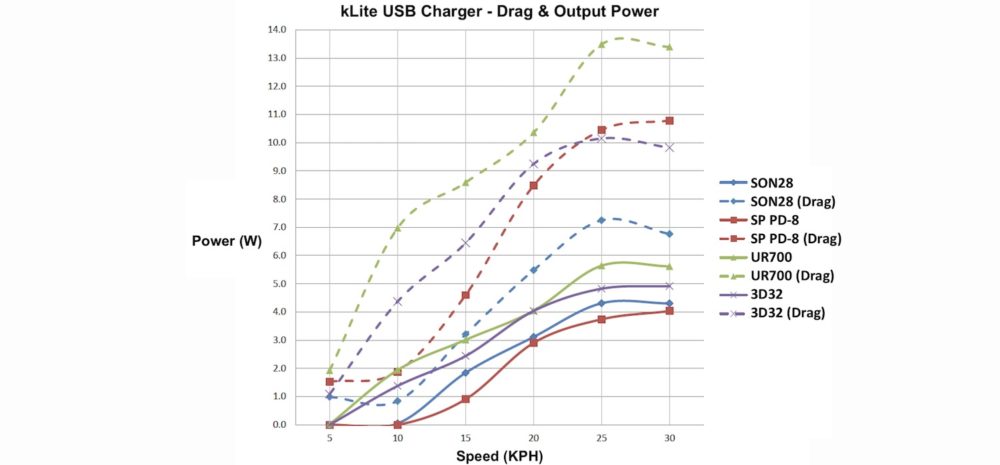
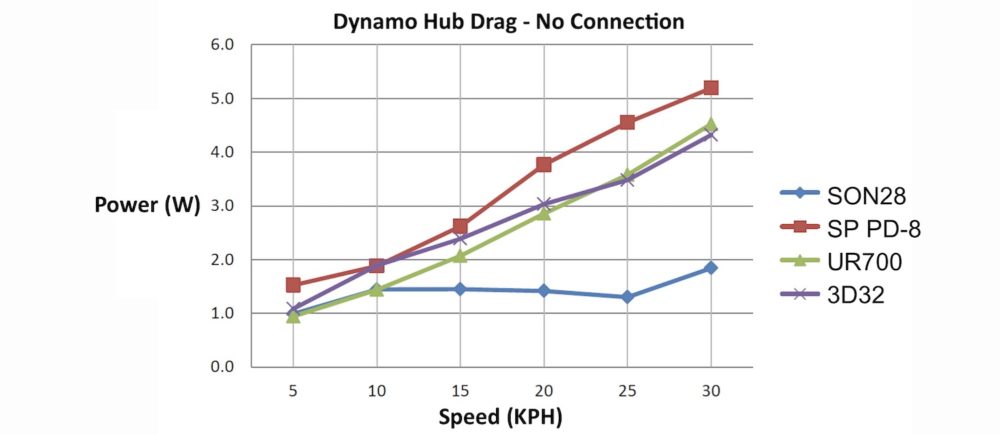
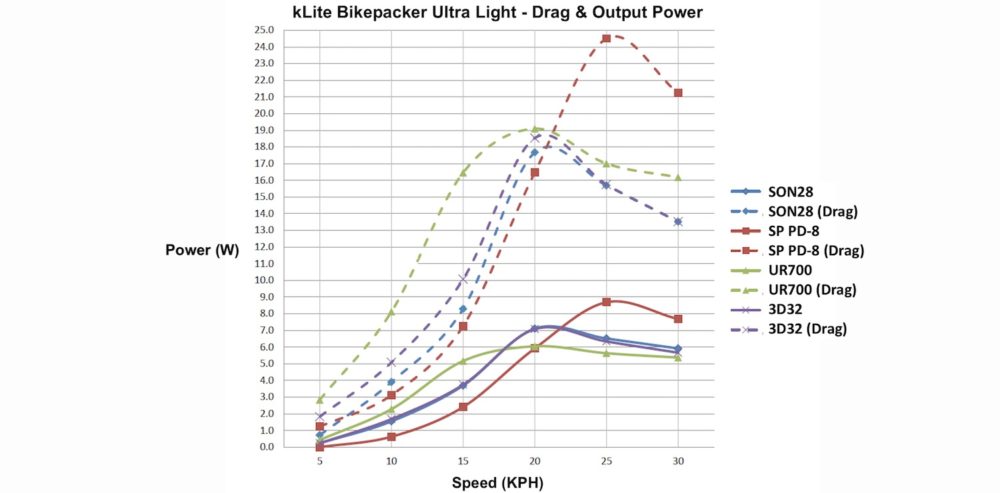
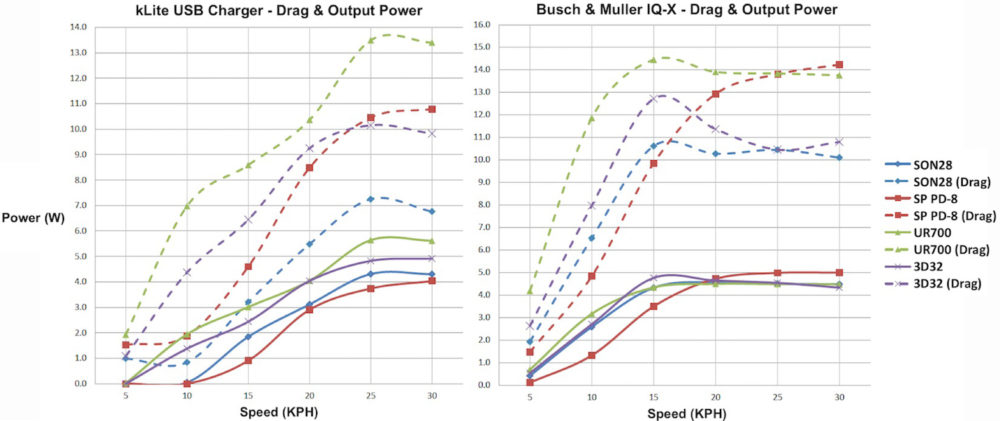
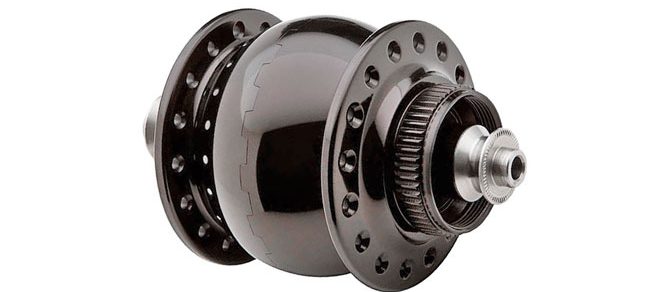
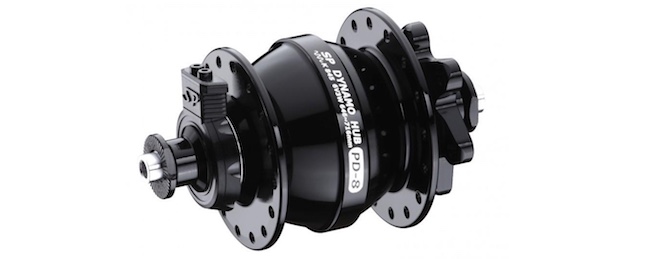
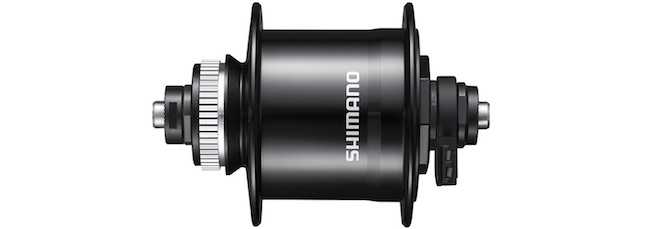

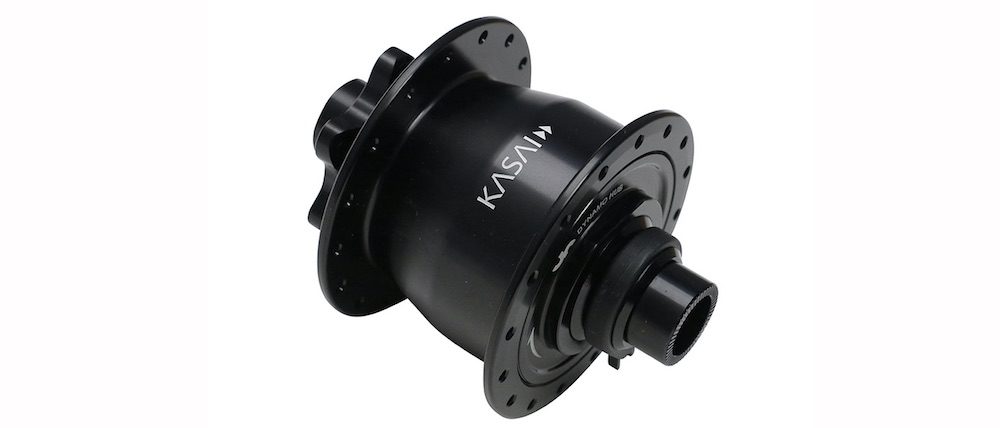
Hello according to the German manufacture of the Son Hubs the 28 is better on a 20 inch wheel and the Deluxe is meant for racing bikes which goes against what you are saying here.
Hi Karl. The reason the delux is great for 16-20″ wheels is because smaller wheels spin faster at any given speed, and the delux being a less powerful dynamo, can still generate enough power for lots of light at low speeds on small wheeled bikes. This hub is ALSO great for road bikes, because their “slow speeds” are much faster than loaded touring cyclists. If you are charging devices from the dynamo hub, it is best to use the SON 28.
Regards
Alee
Thanks but as I said the manufacture doesn’t recommend the deluxe for anything but a racing bike so it is strange that you think differently and I do intend to charge devices and power lights.
The delux actually started out life as a model called the “20r”, intended for 16-20″ wheels. It was only recently that the hub has been given the go-ahead by German legislation to be sold for use on wheels bigger than 20″, hence the name change. Schmidt recommend using the delux for ANY wheel size between 16-28″, not specifically for racing bikes.
That still doesn’t answer the question does it? the people that make the hub don’t recommend the deluxe for small wheels unless you race which I don’t.
Hi Karl. You seem to be stuck on this term “racing”. When Schmidt recommend that the delux is used for “racing” bikes, they are referring to road bikes (or any other full sized bikes) which travel at consistently high speeds, perhaps 20km/h and above. As I’ve already mentioned, the delux hub was originally designed for a 20″ wheel, so to say Schmidt doesn’t recommend the delux hub for 20″ wheels is plain wrong. Alee
Karl. I have supplied you with factual information about where the Delux model has come from to what it is now. Please read over it again from the start. If you want to charge devices, the SON28 is the best for the job on any wheel size. Alee
I have a son 28 on a 20 inch wheel which works just fine and barely notice any drag.
My SON died on me. In its defence it was an old model that came with the used bike, so it might have had a chequered past.
Swapped to an SP. It developed a bad bearing and resulting play after 7-8 months on the road. But the company changed that under warranty, so it only cost me postage from the US to Taiwan. Since I couldn’t wait for the repair I bought a second SP. It’s been fine.
I have owned a SP since 2013 and it is still working well after two tours – over 10,000 kms – and many commutes through all weather conditions (kms unknown). I aim to purchase another one for a Surly Orge I plan to take on the Great Divide tour in August 2016. I use it to power my GPS (Oregon 600) during the day and switch it to power my front light after dark.
Thanks for the mini review, Ted. The SP Dynamo hubs have a great rep, and if I had to purchase another one I’d certainly give one a try!
I have two SON XS-M Dynos, one on each front 20″ wheel of a recumbent trike. One was meant to power a Edelux Lighting system, and does so wonderfully, even at low speeds. The other was rigged to a SuperNova “The Plug” III USB, and was supposed to power my iPhone for navigation and speed and distance tracking, but it does not provide enough power for that. So I wasted about $800 to install something that does not have the power to do what was intended.
Hi Tom. I know very little about the XS-M hub, but on the bright side, your very expensive experiment will help other readers not to buy this hub for charging! Alee
After some investigation, I have found evidence to believe its the USB, not the hub generator. I have a replacement USB port on the way, and I will update this conversation according to the results after it is replaced.
I hope you get it all sorted with you new USB port. 🙂
From what I have read, it seems that charging your phone directly with the hub is not reasonable. What is suggested is charging a separate rechargeable battery pack that you then use to recharge the phone. An extra step and an extra piece of gear but whatever works I guess.
The problem is possibly that the iphone needs 1A to charge, while The Plug only gives 0.5. Options are to first charge into an external battery such as the powermonkey explorer (which charges from very low A), or to get a B&M E-Werk instead of the plug, which is supposed to give up to 1.2 A. I decided on the first.
I haven’t had any charging issues using The Plug 3 and iPhone 5S. 😉
Ok, good to know. I’ll see how it all works out for me when everything is installed.
I hope that some company engineers one to power a large iPhone (5V, 2 Amps,10W) instead of LED lights (3W-6W). Also have it generate enough power at 10 mph/16kph to charge it, but have it generate 0 when going slower than 7 mph so there is no drag going up hills.
Did supernova stop selling dynamo hubs?
Their site only discusses (regular and dynamo) lights;
I didn’t see any mention of hubs.
They have the Plug III under accessories,
but I didn’t see the dynamo at all.
My SP-PD 8X died after a 1100 miles on a 1200 mile tour down the Pacific Coast from Canada. The disc-side bearings became so loose that it became unsafe to ride. Had to replace my front wheel to complete my tour. Very disappointing.
What about the Sturmey-Archer Dynohubs? I’d guess those should have some reputation after so many decades on the market.
I am planning a pedicab route on a hilly declining path, and am concerned about the life of my brake pads/rotors. I am looking for a brand of resistance hub generator, which will offer high resistance in order to govern the speed of the downhill segments and spare my brakes. Ideally this would be able to be activated/deactivated on the fly, or offer variable resistance. Any suggestions?
A dynamo hub is not what you’re looking for. They are very efficient! The Mad Dog Drag Brake is what you want. It’s the only commercial drag brake on the market for bicycles. http://www.maddogdrag.com/
I just received a Shimano Nexus DH-C3000-1N dynamo hub with a new wheel, which was marketed as a Nexus dynamo. I mistakenly thought it was the more popular DH-3N72 Nexus model. Does anyone have any familiarity with the DH-C3000 model. Thanks.
I was looking at a complete wheel on Worldwide Cyclery, and I assume it’s the same thing. Can’t find any info on it either, which is my only hesitation with the purchase. Going on a town bike for me, so I’m sure it’ll be fine. For touring, not sure.
Has anyone tried the Tigra Sport dynamo? It isn’t a hub and it isn’t a friction dynamo either. It seems that it is a good idea, but I’m a little skeptical about the quality of it. I haven’t seen any reviews because it is probably quite new. You can look at it here: https://www.tigrasport.com/activity/136-bikecharge-dynamo-4895161700854.html
I’ve never seen or used the Tigra BikeCharge, but I’d be interested to see how efficient it runs in an independent test.
The Schmidt Son28 will charge most anything you have to include a large USB battery pack even at speeds as slow as 7 mph.
What I would like to see is a hub motor designed specifically for energy Re-capture braking. Pull a trigger and have the motor dig in with heavy resistance slowing the bike and sending the generated power to the drive battery. Oh and can it be weightless too please?!?
None of the USB converters provide enough amperage to charge Apple gear – I’d suggest you invest in some sort of battery bank (make sure it has pass through charging capability)
and then use that to charge your iphone – best use of your investment.
Update… the Great Divide was completed almost a year ago with a PD-8 without issues (~3,400 km) and have just completed a short tour around Lake Ontario (1,100 km). One thing to note on the Great Divide especially is that GPS charging stopped on steep climbs when the speed dropped below about 6 km/hr. This is likely a problem for any dyna hub. Something to note when planning night steep ascents with dyna powered lights. I used a E-Werk USB charger which paired nicely and has stood the test of time. I always take a cache battery with a USB output in case there are infrequent long periods when the speed dropped below the minimum charging threshold. which happened very infrequently. The SPs have been rock solid.
My SONdelux is working fine after 28,000 mi (45,000km). It is on a 700c wheel, and it’s not optimal for charging devices. My city bike has a low-end Shimano dynohub. Shimano’s plug-in connector is far easier to set-up initially, and to re-fit after a flat tire, than SON’s two blade connectors. My new bike has the SON28 “connectorless.” I never turn lights off on these bikes, because the additional drag is so little. The safety of lights on always is worth it to me.
Thanks for the update! You’ll find that USB chargers will require well over 10km/h to get a solid charge; most chargers hit 2 watts at about 15km/h.
Thanks for your impressions on the different dynamo hubs you use!
If my Shimano model number deciphering is good, then what you have there is a 1.5 watt hub, not a 3 watt hub. (In shimano numbering systems: DH = Dynohub C3000 = Model Number and 1N = 1.5 Watt)
I’ve got almost 14,000 miles on my Shutter Precision PV8, installed in 2014, which is still working great. I also have two Sanyo hubs in use. Both are working great, though I don’t think either has hit 1,000 miles yet.
Follow-up: The new SP-PD 8X (which came as a warranty replacement for the 2016 model that died after being exposed to a few days of rain) failed today after being exposed to about 5 days of rain. I’m done with non-user-serviceable dynamo hubs! The SP-PD 8X was a colossal waste of money and time. I need a dynamo hub that I can service after exposure to many miles in the rain. Hard to find online reviews of USER-SERVICEABLE DYNAMO HUBS. I hear Shimano dynamo hubs are user-serviceable. Any others?
Thanks for your reply. That’s very helpful. Can the SON 28 hold up fine over thousands of km in pouring rain too? I’m of the opinion that there’s no bad weather for cycling, just bad clothing. However, after the second failure of the SP PD-8X due to only a few days of riding in the rain, I have learned the hard way that there is more than bad clothing for rainy days, there are bad dynamo hubs too!
Yeah, absolutely. They are the best weather-sealed dynamo hubs on the market.
I read elsewhere that someone’s SON dynamo failed because they left it on its side in the rain while camping and the water must have run into the vent hole. Does that sound right? When water invades a hub (for one reason or another), it would seem best to be able to service it yourself instead of having to break the wheel down and ship the hub for warranty repair, no? I don’t build my own wheels (yet). As such, these warranty repairs are both more expensive and time-consuming than one might assume otherwise. Servicing a hub, on the other hand, is relatively easy and cost-effective for the do-it-yourself home bike mechanic. I was lured into purchasing the SP PD-8X because if the marketing hype of how efficient the hub is, with such low drag. But that matters little if it keeps failing after exposure to a few days of rain. So I’m at the point where I’m okay with higher drag and weight for the convenience of user-serviceability, which I suspect will ultimately extend the life of the hub far beyond most non-user-serviceable dynamo hubs since Murphy’s Law is bound to affect even the best weather-sealed dynamo hubs on the market. What do you think?
Right. My wife’s Schmidt dynohub has been on her daily commuting bike for a little over 9 years now. And it was second-hand then. No trouble at all. Cambridge is not that rainy, but this is the UK so it’s seen plenty of rain over the years. My SP PD8 has only been on my commuter for 6 months but no trouble so far. I’ll tell you in 8 years time how it conmpares 🙂